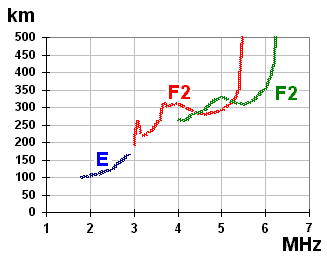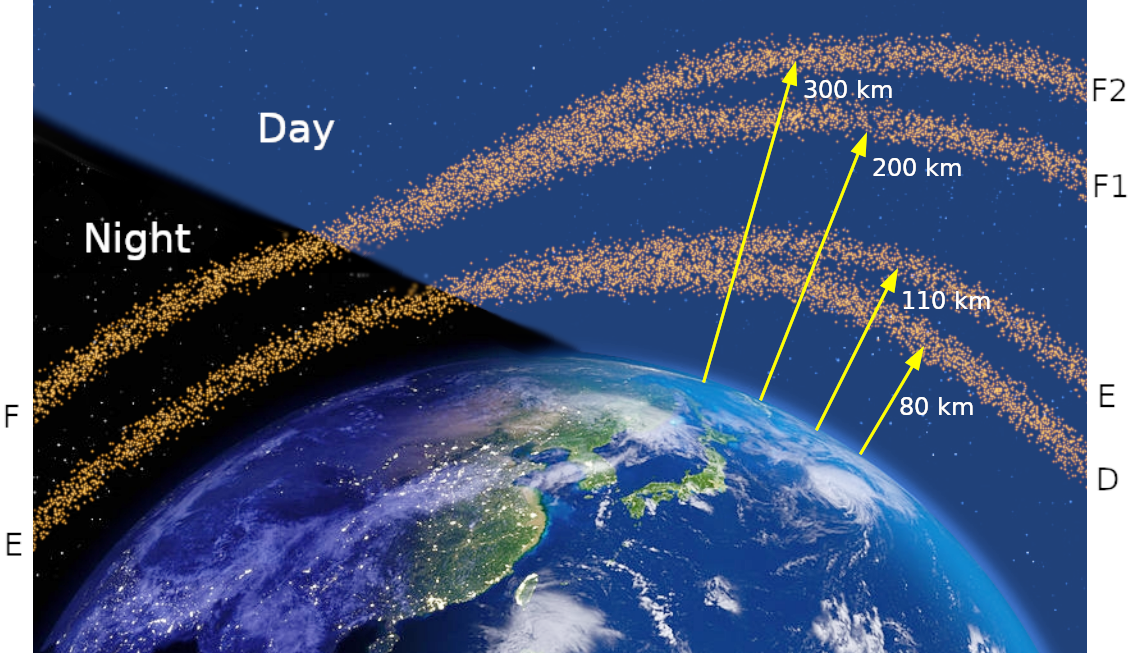|
Ionospheric Sounding
In telecommunication and radio science, an ionospheric sounding is a technique that provides real-time data on high-frequency ionospheric-dependent radio propagation, using a basic system consisting of a synchronized transmitter and receiver. The time delay between transmission and reception is translated into effective ionospheric layer altitude. Vertical incident sounding uses a collocated transmitter and receiver and involves directing a range of frequencies vertically to the ionosphere and measuring the values of the reflected returned signals to determine the effective ionosphere layer altitude. This technique is also used to determine the critical frequency. Oblique sounders use a transmitter at one end of a given propagation path, and a synchronized receiver, usually with an oscilloscope-type display ( ionogram), at the other end. The transmitter emits a stepped- or swept-frequency signal which is displayed or measured at the receiver. The measurement converts time delay ... [...More Info...] [...Related Items...] OR: [Wikipedia] [Google] [Baidu] |
Telecommunication
Telecommunication is the transmission of information by various types of technologies over wire, radio, optical, or other electromagnetic systems. It has its origin in the desire of humans for communication over a distance greater than that feasible with the human voice, but with a similar scale of expediency; thus, slow systems (such as postal mail) are excluded from the field. The transmission media in telecommunication have evolved through numerous stages of technology, from beacons and other visual signals (such as smoke signals, semaphore telegraphs, signal flags, and optical heliographs), to electrical cable and electromagnetic radiation, including light. Such transmission paths are often divided into communication channels, which afford the advantages of multiplexing multiple concurrent communication sessions. ''Telecommunication'' is often used in its plural form. Other examples of pre-modern long-distance communication included audio messages, such as code ... [...More Info...] [...Related Items...] OR: [Wikipedia] [Google] [Baidu] |
Critical Frequency
In telecommunication, the term critical frequency has the following meanings: * In radio propagation by way of the ionosphere, the limiting frequency at or below which a wave component is reflected by, and above which it penetrates through, an ionospheric layer. * At near vertical incidence, the limiting frequency at or below which incidence, the wave component is reflected by, and above which it penetrates through, an ionospheric layer. Critical Frequency changes with time of day, atmospheric conditions and angle of fire of the radio waves by antenna. The existence of the critical frequency is the result of electron limitation, ''i.e.,'' the inadequacy of the existing number of free electrons to support reflection at higher frequencies. In signal processing the ''critical frequency'' it is also another name for the Nyquist frequency. Critical frequency is the highest magnitude of frequency above which the waves penetrate the ionosphere and below which the waves are reflected bac ... [...More Info...] [...Related Items...] OR: [Wikipedia] [Google] [Baidu] |
Edward V
Edward V (2 November 1470 – mid-1483)R. F. Walker, "Princes in the Tower", in S. H. Steinberg et al, ''A New Dictionary of British History'', St. Martin's Press, New York, 1963, p. 286. was ''de jure'' King of England and Lord of Ireland from 9 April to 25 June 1483. He succeeded his father, Edward IV, upon the latter's death. Edward V was never crowned, and his brief reign was dominated by the influence of his uncle and Lord Protector, the Duke of Gloucester, who deposed him to reign as King Richard III; this was confirmed by the Act entitled '' Titulus Regius'', which denounced any further claims through his father's heirs. Edward V and his younger brother Richard of Shrewsbury, Duke of York, were the Princes in the Tower who disappeared after being sent to heavily guarded royal lodgings in the Tower of London. Responsibility for their deaths is widely attributed to Richard III, but the lack of solid evidence and conflicting contemporary accounts allow for other possi ... [...More Info...] [...Related Items...] OR: [Wikipedia] [Google] [Baidu] |
Kennelly–Heaviside Layer
The Heaviside layer, sometimes called the Kennelly–Heaviside layer, named after Arthur E. Kennelly and Oliver Heaviside, is a layer of ionised gas occurring roughly between 90km and 150 km (56 and 93 mi) above the ground — one of several layers in the Earth's ionosphere. It is also known as the E region. It reflects medium-frequency radio waves. Because of this reflective layer, radio waves radiated into the sky can return to Earth beyond the horizon. This " skywave" or "skip" propagation technique has been used since the 1920s for radio communication at long distances, up to transcontinental distances. Propagation is affected by the time of day. During the daytime the solar wind presses this layer closer to the Earth, thereby limiting how far it can reflect radio waves. Conversely, on the night (lee) side of the Earth, the solar wind drags the ionosphere further away, thereby greatly increasing the range which radio waves can travel by reflection. The ... [...More Info...] [...Related Items...] OR: [Wikipedia] [Google] [Baidu] |
Time
Time is the continued sequence of existence and events that occurs in an apparently irreversible succession from the past, through the present, into the future. It is a component quantity of various measurements used to sequence events, to compare the duration of events or the intervals between them, and to quantify rates of change of quantities in material reality or in the conscious experience. Time is often referred to as a fourth dimension, along with three spatial dimensions. Time has long been an important subject of study in religion, philosophy, and science, but defining it in a manner applicable to all fields without circularity has consistently eluded scholars. Nevertheless, diverse fields such as business, industry, sports, the sciences, and the performing arts all incorporate some notion of time into their respective measuring systems. 108 pages. Time in physics is operationally defined as "what a clock reads". The physical nature of time is a ... [...More Info...] [...Related Items...] OR: [Wikipedia] [Google] [Baidu] |
Signalling (telecommunication)
In telecommunication, signaling is the use of signals for controlling communications. This may constitute an information exchange concerning the establishment and control of a telecommunication circuit and the management of the network. Classification Signaling systems may be classified based on several principal characteristics. In-band and out-of-band signaling In the public switched telephone network (PSTN), in-band signaling is the exchange of call control information within the same physical channel, or within the same frequency band, that the telephone call itself is using. An example is dual-tone multi-frequency signaling (DTMF), which is used on most telephone lines to customer premises. Out-of-band signaling is telecommunication signaling on a dedicated channel separate from that used for the telephone call. Out-of-band signaling has been used since Signaling System No. 6 (SS6) was introduced in the 1970s, and also in Signalling System No. 7 (SS7) in 1980 which bec ... [...More Info...] [...Related Items...] OR: [Wikipedia] [Google] [Baidu] |
Frequency
Frequency is the number of occurrences of a repeating event per unit of time. It is also occasionally referred to as ''temporal frequency'' for clarity, and is distinct from '' angular frequency''. Frequency is measured in hertz (Hz) which is equal to one event per second. The period is the interval of time between events, so the period is the reciprocal of the frequency. For example, if a heart beats at a frequency of 120 times a minute (2 hertz), the period, —the interval at which the beats repeat—is half a second (60 seconds divided by 120 beats). Frequency is an important parameter used in science and engineering to specify the rate of oscillatory and vibratory phenomena, such as mechanical vibrations, audio signals ( sound), radio waves, and light. Definitions and units For cyclical phenomena such as oscillations, waves, or for examples of simple harmonic motion, the term ''frequency'' is defined as the number of cycles or vibrations per unit of ... [...More Info...] [...Related Items...] OR: [Wikipedia] [Google] [Baidu] |
Ionogram
An ionosonde, or chirpsounder, is a special radar for the examination of the ionosphere. The basic ionosonde technology was invented in 1925 by Gregory Breit and Merle A. Tuve and further developed in the late 1920s by a number of prominent physicists, including Edward Victor Appleton. The term '' ionosphere'' and hence, the etymology of its derivatives, was proposed by Robert Watson-Watt. Components An ionosonde consists of: * A high frequency (HF) radio transmitter, automatically tunable over a wide range. Typically the frequency coverage is 0.5–23 MHz or 1–40 MHz, though normally sweeps are confined to approximately 1.6–12 MHz. * A tracking HF receiver which can automatically track the frequency of the transmitter. * An antenna with a suitable radiation pattern, which transmits well vertically upwards and is efficient over the whole frequency range used. * Digital control and data analysis circuits. The transmitter sweeps all or part of the HF frequenc ... [...More Info...] [...Related Items...] OR: [Wikipedia] [Google] [Baidu] |
Ionosphere
The ionosphere () is the ionized part of the upper atmosphere of Earth, from about to above sea level, a region that includes the thermosphere and parts of the mesosphere and exosphere. The ionosphere is ionized by solar radiation. It plays an important role in atmospheric electricity and forms the inner edge of the magnetosphere. It has practical importance because, among other functions, it influences radio propagation to distant places on Earth. History of discovery As early as 1839, the German mathematician and physicist Carl Friedrich Gauss postulated that an electrically conducting region of the atmosphere could account for observed variations of Earth's magnetic field. Sixty years later, Guglielmo Marconi received the first trans-Atlantic radio signal on December 12, 1901, in St. John's, Newfoundland (now in Canada) using a kite-supported antenna for reception. The transmitting station in Poldhu, Cornwall, used a spark-gap transmitter to produce a signal with a f ... [...More Info...] [...Related Items...] OR: [Wikipedia] [Google] [Baidu] |
Radio Science
One way of outlining the subject of ''radio science'' is listing the topics associated with it by authoritative bodies. Union of Radio Science International (URSI) The International Union of Radio Science has several commissions corresponding to the following topics of interest: * Commission A – Electromagnetic metrology ** Antennas ** Atomic-based mechatronics ** Bioeffects and medical applications ** Electromagnetic compatibility (EMC) and EM Metrology, metrology ** High-frequency and Millimetre, millimeter wireless metrology ** Micropower impulse radar, Impulse radar ** Interconnector, Interconnect and packaging ** Materials ** Measurements and calibration in propagation ** Microwave to sub-millimeter measurements/standards ** Noise ** Quantum metrology and fundamental concepts ** Space plasma characterization ** Techniques for remote sensing ** Test facilities ** Tetrahertz (THz) metrology ** Time and frequency ** Time-domain metrology * Commission B – Fields ... [...More Info...] [...Related Items...] OR: [Wikipedia] [Google] [Baidu] |
Ionospheric Layer
The ionosphere () is the ionized Ionization, or Ionisation is the process by which an atom or a molecule acquires a negative or positive charge by gaining or losing electrons, often in conjunction with other chemical changes. The resulting electrically charged atom or molecule ... part of the upper atmosphere of Earth, from about to height above sea level, above sea level, a region that includes the thermosphere and parts of the mesosphere and exosphere. The ionosphere is ionized by solar irradiance, solar radiation. It plays an important role in atmospheric electricity and forms the inner edge of the magnetosphere. It has practical importance because, among other functions, it influences radio propagation to distant places on Earth. History of discovery As early as 1839, the German mathematician and physicist Carl Friedrich Gauss postulated that an electrically conducting region of the atmosphere could account for observed variations of Earth's magnetic field. Sixty years ... [...More Info...] [...Related Items...] OR: [Wikipedia] [Google] [Baidu] |
Transmission (telecommunications)
In telecommunications, transmission is the process of sending or propagating an analog or digital signal via a medium that is wired, wireless, or fiber-optic. Transmission technologies typically refer to physical layer protocol duties such as modulation, demodulation, line coding, equalization, error control, bit synchronization and multiplexing, but it may also involve higher-layer protocol duties, for example, digitizing an analog signal, and data compression. Transmission of a digital message, or of a digitized analog signal, is known as data transmission Data transmission and data reception or, more broadly, data communication or digital communications is the transfer and reception of data in the form of a digital bitstream or a digitized analog signal transmitted over a point-to-point o .... Examples of transmission are the sending of signals with limited duration, for example, a block or packet of data, a phone call, or an email. See also * R ... [...More Info...] [...Related Items...] OR: [Wikipedia] [Google] [Baidu] |





